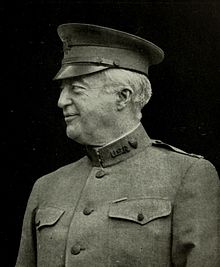Augustus P. Gardner
Augustus Peabody Gardner | |
|---|---|
 Major Gardner in uniform. | |
| Member of the U.S. House of Representatives from Massachusetts's 6th district | |
| In office November 4, 1902 – May 15, 1917 | |
| Preceded by | William Henry Moody |
| Succeeded by | Willfred W. Lufkin |
| Massachusetts Senate Third Essex District | |
| In office January 1900 – 1901 | |
| Preceded by | Charles O. Bailey |
| Succeeded by | Harry C. Foster |
| Personal details | |
| Born | November 5, 1865 Boston, Massachusetts |
| Died | January 14, 1918 (aged 52) Camp Wheeler, Macon, Georgia |
| Nationality | American |
| Political party | Republican |
| Spouse | Constance Lodge (m. June 15, 1892) |
| Children | Constance Gardner |
| Alma mater | Harvard, A.B., 1886 |
| Awards | Distinguished Service Medal |
| Military service | |
| Allegiance | United States of America |
| Branch/service | United States Army |
| Years of service | 1898 1917–1918 |
| Rank | Captain and assistant Adjutant General Colonel, Major |
| Unit | Adjutant General's Department 31st Division 121st Regiment, United States Infantry |
| Battles/wars | Spanish–American War Battle of Coamo World War I |
Augustus Peabody Gardner (November 5, 1865 – January 14, 1918) was a Representative from Massachusetts. Gardner was the son-in-law of Henry Cabot Lodge.
Biography

Gardner was born on November 5, 1865 in Boston, Massachusetts to Joseph Peabody Gardner and Harriet Sears Amory.[1] He was the descendant of Thomas Gardner (planter) and nephew of John Lowell "Jack" Gardner II whose wife was Isabella Stewart Gardner. Jack and Isabella 'adopted' Augustus and his two brothers (Joseph and William) after the death of their father in 1875. Their mother had died in 1865.[2] He graduated from Harvard University in 1886. He studied law at Harvard Law School, but never practised, instead devoting himself to the management of his estate.
On June 14, 1892, Gardner married Constance Lodge, daughter of Henry Cabot Lodge, at Saint Anne's Church, Nahant, Massachusetts. After his death, Constance married Major General Charles Clarence Williams who served as U.S. Army Chief of Ordnance from July 1918 until April 1930.
Spanish–American War
Gardner served in the Spanish–American War as a captain and assistant adjutant general on the staff of Major General James Wilson and fought at the Battle of Coamo. He served from May 12 to December 31, 1898.
Political office
He was elected a member of the Massachusetts Senate in 1899 and served from 1900 to 1901. Gardner was elected, as a Republican, to the Fifty-seventh Congress by special election, after the resignation of United States Representative William H. Moody. Gardner was reelected to the eight succeeding Congresses (November 4, 1902 – May 15, 1917). Gardner was the chairman of the Committee on Industrial Arts and Expositions during the Fifty-ninth and Sixtieth Congresses.
Rescue of the Lodges from France
At the beginning of World War I, Gardner's Sister in law, Mrs. George Cabot Lodge and her children Henry, John, and Helene were stranded in France. In August 1914 Gardner traveled to France to extract them, and to bring them to safety in London.[3]
World War I
Shortly after the United States declared war on Germany in April 1917, Gardner resigned from Congress to enter the Army on May 24, 1917 as a colonel in the Adjutant General's Department. He was first assigned to the headquarters of the Eastern Department at Governors Island in New York Harbor and later as adjutant of the 31st Division.
Desiring combat duty, he requested and accepted a demotion to the rank of major on December 8, 1917. He was then placed in command of the 1st Battalion, 121st Infantry, 31st Division at Camp Wheeler in Georgia.
Gardner died of pneumonia while on active duty at Macon, Georgia on January 14, 1918. He was buried in Arlington National Cemetery.
In 1923, he was posthumously awarded the Distinguished Service Medal for meritorious service during the World War I. His award citation states, "His entire service was characterized by untiring zeal, devotion to duty and marked success."[4] His other military awards were the Spanish Campaign Medal and the World War I Victory Medal.
References
- United States Congress. "Augustus P. Gardner (id: G000050)". Biographical Directory of the United States Congress.
- Notes
- ^ Gardner, Constance Lodge (1919), Augustus Peabody Gardner, Major, United States National Guard, 1865–1918, Cambridge, MA: Constance Gardner, printed at the Riverside press, p. 1
- ^ Gardner, Frank A MD [1933] Gardner Memorial: A Biographical and Genealogical Record of the Descendants of Thomas Gardner, Planter, Cape Ann, 1624, Salem ISBN 978-0-7404-2590-5
- ^ Boston Evening Transcript (August 7, 1914), "Lodge and Gardner Safe: Families of Both now in London-Gardner Praises American Officials at Havre", The Boston Evening Transcript, Boston, MA, p. 3
- ^ American Decorations, 1862–1926. pg. 706.
Further reading
- Gardner, Constance Lodge.: Augustus Peabody Gardner, Major, United States National Guard, 1865-1918 (1919).
- Who's who in State Politics, 1912 Practical Politics p. 18 (1912).
- New York Times, "Gardiner-Lodge" Page 4, (June 15, 1892).
- New York Times, "Maj. Gardner Dies at Camp Wheeler; Author of the Famous 'Wake Up, America!' Speech a Victim of Pneumonia at 52. 15 YEARS IN CONGRESS Ex-Massachusetts Representative Was the First Member to Leave for Military Service. A Graduate of Harvard. A Champion of Labor. His Tribute to France." page 13, (January 15, 1918).
External links
- 1865 births
- 1918 deaths
- Massachusetts State Senators
- Members of the United States House of Representatives from Massachusetts
- Harvard University alumni
- Massachusetts Republicans
- Recipients of the Distinguished Service Medal (United States)
- Deaths from pneumonia
- Republican Party members of the United States House of Representatives
- United States Army colonels
- 19th-century American politicians


